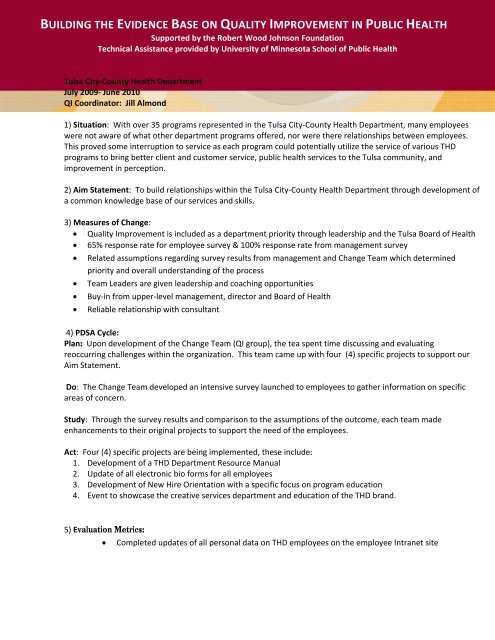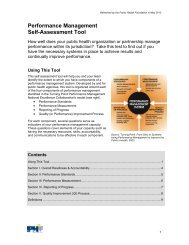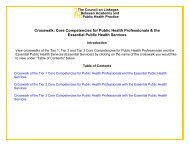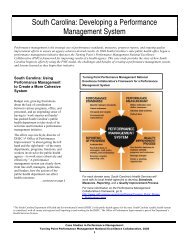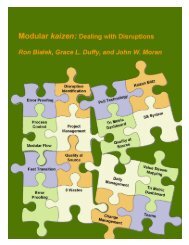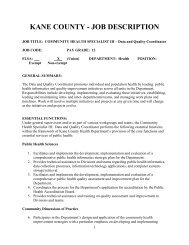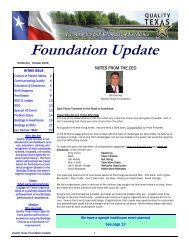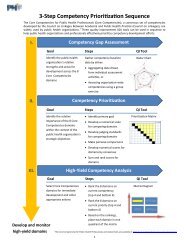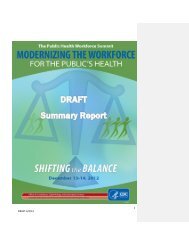Mid year evaluation storyboard template June 2010 THD
Mid year evaluation storyboard template June 2010 THD
Mid year evaluation storyboard template June 2010 THD
You also want an ePaper? Increase the reach of your titles
YUMPU automatically turns print PDFs into web optimized ePapers that Google loves.
BUILDING THE EVIDENCE BASE ON QUALITY IMPROVEMENT IN PUBLIC HEALTH<br />
Supported by the Robert Wood Johnson Foundation<br />
Technical Assistance provided by University of Minnesota School of Public Health<br />
Tulsa City‐County Health Department<br />
July 2009‐ <strong>June</strong> <strong>2010</strong><br />
QI Coordinator: Jill Almond<br />
1) Situation: With over 35 programs represented in the Tulsa City‐County Health Department, many employees<br />
were not aware of what other department programs offered, nor were there relationships between employees.<br />
This proved some interruption to service as each program could potentially utilize the service of various <strong>THD</strong><br />
programs to bring better client and customer service, public health services to the Tulsa community, and<br />
improvement in perception.<br />
2) Aim Statement: To build relationships within the Tulsa City‐County Health Department through development of<br />
a common knowledge base of our services and skills.<br />
3) Measures of Change:<br />
• Quality Improvement is included as a department priority through leadership and the Tulsa Board of Health<br />
• 65% response rate for employee survey & 100% response rate from management survey<br />
• Related assumptions regarding survey results from management and Change Team which determined<br />
priority and overall understanding of the process<br />
• Team Leaders are given leadership and coaching opportunities<br />
• Buy‐in from upper‐level management, director and Board of Health<br />
• Reliable relationship with consultant<br />
4) PDSA Cycle:<br />
Plan: Upon development of the Change Team (QI group), the tea spent time discussing and evaluating<br />
reoccurring challenges within the organization. This team came up with four (4) specific projects to support our<br />
Aim Statement.<br />
Do: The Change Team developed an intensive survey launched to employees to gather information on specific<br />
areas of concern.<br />
Study: Through the survey results and comparison to the assumptions of the outcome, each team made<br />
enhancements to their original projects to support the need of the employees.<br />
Act: Four (4) specific projects are being implemented, these include:<br />
1. Development of a <strong>THD</strong> Department Resource Manual<br />
2. Update of all electronic bio forms for all employees<br />
3. Development of New Hire Orientation with a specific focus on program education<br />
4. Event to showcase the creative services department and education of the <strong>THD</strong> brand.<br />
5) Evaluation Metrics: :<br />
• Completed updates of all personal data on <strong>THD</strong> employees on the employee Intranet site
• Creation of a reference manual that will be used to broaden the knowledge of all programs within<br />
the department<br />
• Coordination of Marketing “art” show that will display all projects that have been completed inhouse<br />
and education of branding standards<br />
• Creation and implementation of Department Orientation program for existing employees and new<br />
hires<br />
• Implementation schedule to be followed and final <strong>evaluation</strong> to be conducted January‐ <strong>June</strong> 2011<br />
6) Lessons Learned:<br />
Using the QI process to identify specific projects and format for improvement, we have found:<br />
• Education of <strong>THD</strong> leadership of complexity of QI tools<br />
• Specific education of all <strong>THD</strong> employees so that they understand what QI is and that the projects in<br />
<strong>THD</strong> are for their development and support.<br />
• Change team does need a break to focus on specific job responsiblities<br />
• New “apprentices” will be recruited to support or replace existing members. A smaller Quality<br />
Improvement Council will be developed at the end of the full program implementation.


